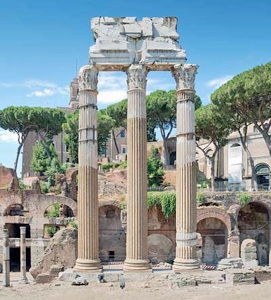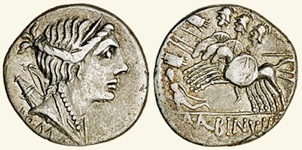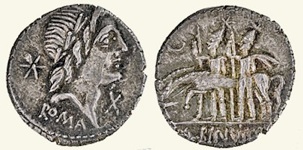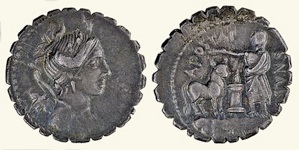Rome in the Early Republic (509 - 241 BC)
Temple of Castor and Pollux 484 BC)


Rome in the Early Republic (509 - 241 BC)
Temple of Castor and Pollux 484 BC)

Re-erected columns from the temple of Castor and Pollux,
(probably from its restoration in 6 AD)
According to Livy, at a crucial moment that led to the Romans’ victory over the Latins at Lake Regillus (in the territory of Tusculum) in 499 or 496 BC, the dictator Aulus Postumius Albus:
“... is said to have vowed a temple to Castor ...”, (‘History of Rome’, 2: 20: 12).
In a later passage, Livy recorded that:
“The temple of Castor was dedicated on 15th of July [484 BC]. It had been vowed during the Latin war by Postumius, the dictator. His son, having been made duovir for this special purpose [presumably after the dictator’s death], dedicated it”, (‘History of Rome’, 2: 42: 4).
According to Ovid, on 27th January:
“... a temple was dedicated to Leda’s divine sons, [Castor and Pollux], brothers of the race of the gods founded that temple for the brother gods beside Juturna’s pools”, ‘Fasti,. 1: 705-8, translated by James Frazer, referenced below, at p. 53).
This date is also recorded as the dies natalis of the temple of:
✴[Castoris et Po]llucis, in the fasti Praenestini; and
✴Castori, Polluci ad Forum, in the fasti Verulani (see Howard Scullard, referenced below, at p. 65).
Dionysius of Halicarnassus gave a more elaborate account of these events:
“It is said that, during the battle at Lake Regillus, two men on horseback, far excelling ordinary humans in both beauty and stature and just growing their first beards, appeared to Postumius, the dictator, and to those arrayed about him, and charged at the head of the Roman horse, ... driving [the enemy] headlong before them. Furthermore, after the flight of the Latins and the capture of their camp, ... two youths are said to have appeared in the same manner in the Roman Forum attired in military garb ... [with] the horses they led being all in a sweat. When they had watered their horses and washed them at the fountain that rises near the temple of Vesta, ... many people stood about them and inquired if they brought any news from the camp. They announced how the battle had gone and that the Romans were the victors. It is said that, after they left the Forum, they were not seen again by anyone, though great search was made for them by the man who had been left in command of the City. The next day, when those at the head of affairs received the letters from the dictator and ... learned of the appearance of the divinities, they presumably concluded ... that it was the same gods that had appeared in both places, and were convinced that the apparitions had been those of Castor and Pollux”, (‘Roman Antiquities’, 6: 13: 1-3).
Dionysius then observed that:
“There are many monuments to this extraordinary and wonderful appearance of these gods at Rome:
✴the temple of Castor and Pollux, which the City erected in the Forum, at the place where their apparitions had been seen;
✴the adjacent fountain, which bears the names of these gods and is to this day regarded as holy;
✴the costly sacrifices that the people perform each year through their chief priests on [15th of July], the day on which they gained this victory; and
✴the procession performed after the sacrifice by those who have a public horse and who, being arrayed by tribes and centuries, ride in regular ranks on horseback, as if they came from battle, crowned with olive branches and attired in the purple robes with stripes of scarlet which they call trabeae. They begin their procession from a certain temple of Mars built outside the walls and, going through several parts of the City and the Forum, tpass by the temple of Castor and Pollux, ... wearing whatever rewards for valour in battle they have received from their commanders ...
These are the things I have found both related and performed by the Romans in commemoration of the appearance of Castor and Pollux; and from these, as well as from many other important instances, one may judge how dear to the gods were the men of those times”, (‘Roman Antiquities’, 6: 13: 4-5).
Epiphany of Castor and Pollux in 168 BC
In his book on the ‘Nature of the Gods’, Cicero observed that:
“... the gods often manifest their power in bodily presence. For instance:
✴in the Latin War, at the critical battle of Lake Regillus between the dictator Aulus Postumius [Albus] and Octavius Mamilius of Tusculum, Castor and Pollux were seen fighting on horseback in our ranks; and
✴in more modern history, [i.e., in 168 BC, Castor and Pollux also] brought the news of the defeat of Perseus [of Macedonia at the battle of Pydna]. What happened was that P. Vatinius, the grandfather of our young contemporary, [P. Vatinius (cos 47 BC)] was returning to Rome by night from Reate, of which he was governor, when he was informed by two young warriors on white horses that King Perseus had been taken prisoner on that very day. When Vatinius carried the news to the Senate, at first he was flung into jail on the charge of spreading an unfounded report on a matter of national concern; but, when a dispatch arrived from [Aemilius] Paulus and the date was found to tally, the Senate granted land Vatinius and exempted him from military service”, (‘Nature of the Gods’, 2: 6, translated by Henry Rackham, referenced below, at pp. 127-9).

Denarius issued in Rome by A. Postumius Albinus (RRC 335/9, ca. 96 BC)
Obverse: Bust of Diana (with bow and quiver over her shoulder)
Reverse: A·A͡LBINVS·S·F: Three horsemen charging towards two standards and a fallen enemy soldier

Denarius issued in Rome by A. Postumius Albinus (RRC 335/10, ca. 96 BC)
Obverse: ROMA: Bust of Apollo, star behind
Reverse: A·POST·A·F·S·N·A͡LBIN: Dioscuri watering horses at the Lacus Juturnae, crescent to left

Denarius serratus issued in Rome by A. Postumius Albinus (RRC 372/1, 81 BC)
Obverse: Bust of Diana (with bow and quiver over her shoulder), bucranium (skull of a sacrificed bull) above
Reverse: A·POST·A·F·S·N·A͡LBIN: Priest preparing a bull for sacrifice at the altar of Diana on the Aventine (see below)
Read more:
Scullard H. H., “Festivals and Ceremonies of the Roman Republic”, (1981) London
Rackham H. (translator), “Cicero:On the Nature of the God; Academics.”, (1933) Cambridge MA
Frazer J. (translator), “Ovid: Fasti”, (1931) Cambridge MA
Return to Rome in the Early Republic (509 - 241 BC)